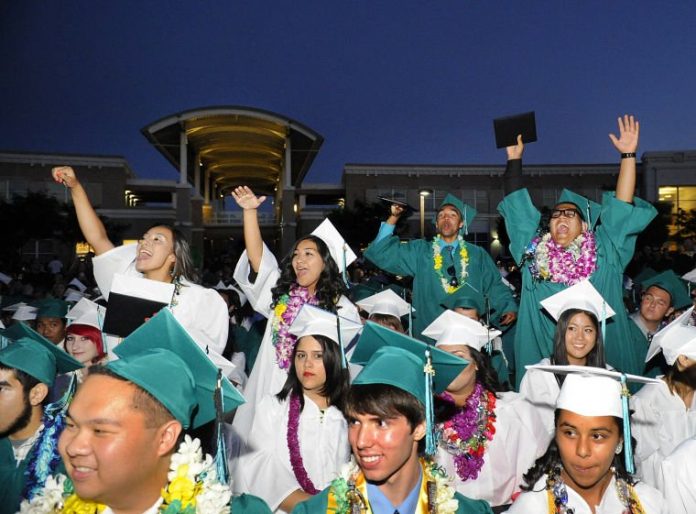
Nearly one in four seniors is in danger of not getting a diploma this year, despite email blasts, one-on-one meetings with school staff and personalized letters warning students they’ve fallen behind the required 80 hours of community service needed to graduate.
According to an early review in January of timesheets on record at all four of Gilroy’s high schools, 24 percent, or 200 seniors, hadn’t handed in a single timesheet and therefore have no service hours on record.
The latest update given to trustees during the Gilroy Unified School District Board of Education meeting has administrators alarmed over a controversial rule implemented four years ago. School Board trustees enthusiastically passed the mandate with flying colors in August 2010, but getting students to stay on track and not procrastinate continues to be a thorn in administrators’ sides.
Superintendent Debbie Flores reiterated no slack will be allowed for those who fail to log the necessary hours.
“Students have to meet this requirement. There will be no exceptions,” she said.
A few mini deadlines have already been put in place, and students who don’t meet them are barred from purchasing tickets for Grad Night and several school dances, including prom. Those who don’t finish their full 80 hours by the final deadline – which falls about a month before each school’s graduation day – have to keep working over the summer if they want a diploma and a chance to walk in a smaller ceremony at the end of summer.
The fact that 200 seniors “haven’t gotten this message” despite staff efforts to spell out the graduation requirements and volunteer opportunities tells Flores “they clearly aren’t taking this seriously.”
There is no set rule for how many hours must be completed each year, although students are strongly encouraged to log at least 20 per year. Aside from those guidelines, Flores cited numerous outreach efforts made by district staff to help nudge students along. A designated staff member at each of Gilroy’s four high schools (Gilroy and Christopher High, the Gilroy Early College Academy, or GECA, and Mt. Madonna Continuation) is tasked with maintaining a running list of volunteer opportunities, helping students log and keep track of their hours and sending out reminders to families when students fall behind.
This spring marks the first year in which seniors need to have 80 hours of service under their belts in order to walk. Flores is already expecting at least 50 and possibly as many as 100 won’t make it. She hopes that most of the 200 students have completed their hours but failed to turn in a timesheet.
CHS and GHS have taken the carrot-and-stick approach – awarding teens who meet the requirements with positive recognition on school websites or during the morning announcements and alternately taking away privileges such as the right to boogie it up at school dances for students that fall short on hours.
“I don’t think it was taken that seriously our freshmen year,” explained GHS ASB President Bryan Kachakji. “It was kind of four years from now that’s something we’ll deal with as seniors.”
To walk, students must earn 10 hours in at least two of the following categories: senior citizens, disabled citizens, the environment, literacy, promoting health and wellness, promoting the arts and culture, young children, schools, the homeless or animal care.
“We wanted kids to have different opportunities,” said Flores, who notes that students might tend to want to do all their hours in just one area. “We wanted to get them out in the community.”
Flores previously worked in the Santa Barbara Unified School District, where a community service graduation requirement was in place. As Assistant Superintendent, Flores was in charge of carrying it out.
“I heard that in the early days it was challenging but within a very short period of time students learned it was a requirement and they had to do it,” said Flores.
Staff at all four GUSD high schools are working hard to dispel misconceptions about the rule, including the idea that students short just a few hours will still be allowed to walk.
It’s also about setting the stage for next year.
“It’s becoming more of a culture for our students,” explained Julie Berggren, the Community Service Coordinator for GHS. “The freshmen, sophomores and juniors – they’re already on it. They’ve turned in more timesheets than the senior class ever did.”
It’s not just the low achieving students that aren’t turning in hours, either, according to high school staff.
“A lot of friends have it signed and haven’t brought it in,” said CHS ASB President Grace Gullen, who regularly announces places students can volunteer as part of the morning announcements. “The only kids that would dare to do none (of the hours) are the super trouble-making kids.”
The new policy continues to elicit divided opinions from the student body.
“Some students are slightly frustrated because they feel helping some kids outside of school isn’t necessarily related to their academic efforts that they’ve put forth all through high school, but some love it because it forces them to get involved,” explained Gullen, who logged an impressive 105 hours of community service at the South Valley Community Church, the Gilroy Demonstration Garden and the Gilroy Garlic Festival.
As the deadlines for senior dances and activities approach, timesheets are flooding in, according to Flores, who heard an update from school principals at a meeting Wednesday morning. District staff will run a report in four weeks to check the new numbers.
That said, not everyone cares about dances – meaning taking away such privileges doesn’t motivate everyone, explained several school district staff members as they brainstormed ways to give teeth to the new requirement at the Jan. 16 school district meeting.
“Maybe I missed this, but why aren’t we tapping into athletics and extracurricular activities?” asked trustee Fred Tovar, who originally suggested a 120- to 200-hour requirement back when the idea was first discussed four years ago.
Not everyone was convinced that clamping down on sports involvement and other outside-school activities would get students on board to complete their hours.
“I would like to talk about that further though because sometimes those extracurricular activities are what’s keeping them connected to school,” Flores pointed out.
In the mean time, the YMCA Youth Advocates program is trying to help students reach their 80-hour goal in just one year. Students go through a series of workshop trainings, then get straight to volunteering at homework tutorials, the senior center, and after-school nutrition and physical activities programs at various local schools.
“It’s about our high school students learning about themselves and how they can give back to their community,” said Rafael Arce, the YMCA Director of Healthy Living Programs who led about 40 students through the program last year and expects a similar number this year.
Despite the paperwork nightmares of making the new rule a reality, Flores says it’s a step in the right direction for the students: “At the end, we’re going to have entire classes of students that have engaged in their community and will hopefully make this a life time habit.”
Hours of community service on record between Gilroy’s four high schools:
No hours completed: 24 percent (200 students)
1-19 hours completed: 3 percent (28 students)
20-39 hours completed: 8 percent (70 students)
40-59 hours: 13 percent (108 students)
60-79 hours: 19 percent (158 students)
All 80 hours completed: 32 percent (260 students)













